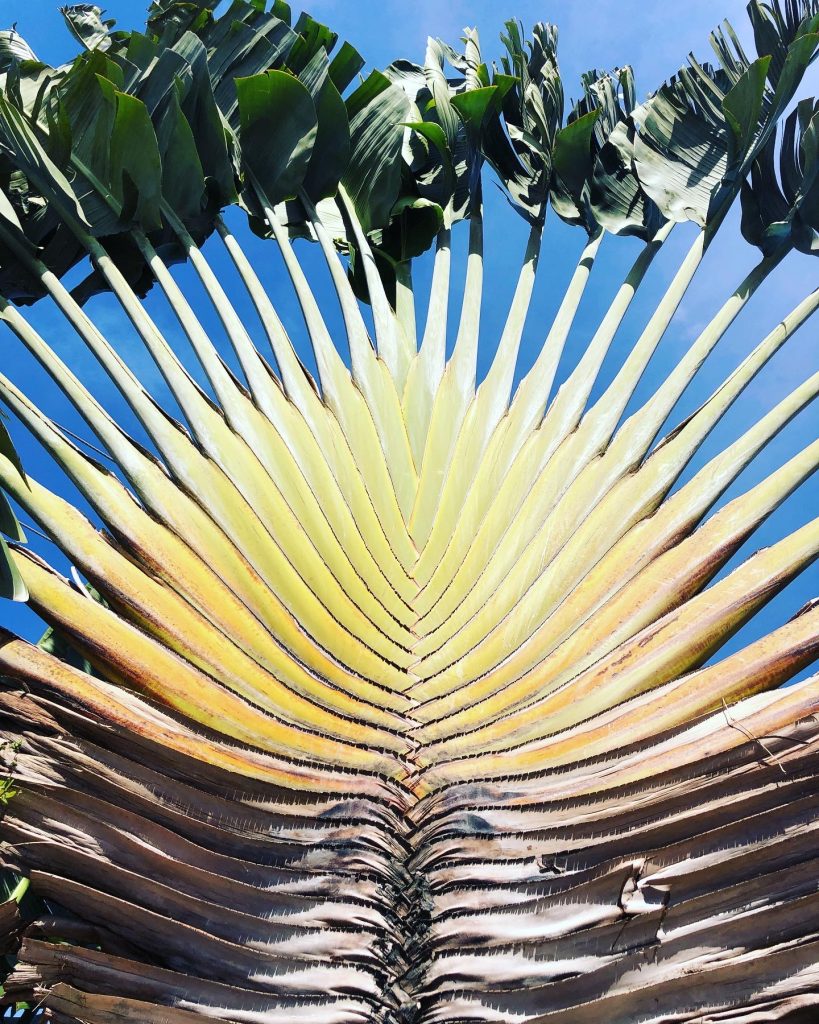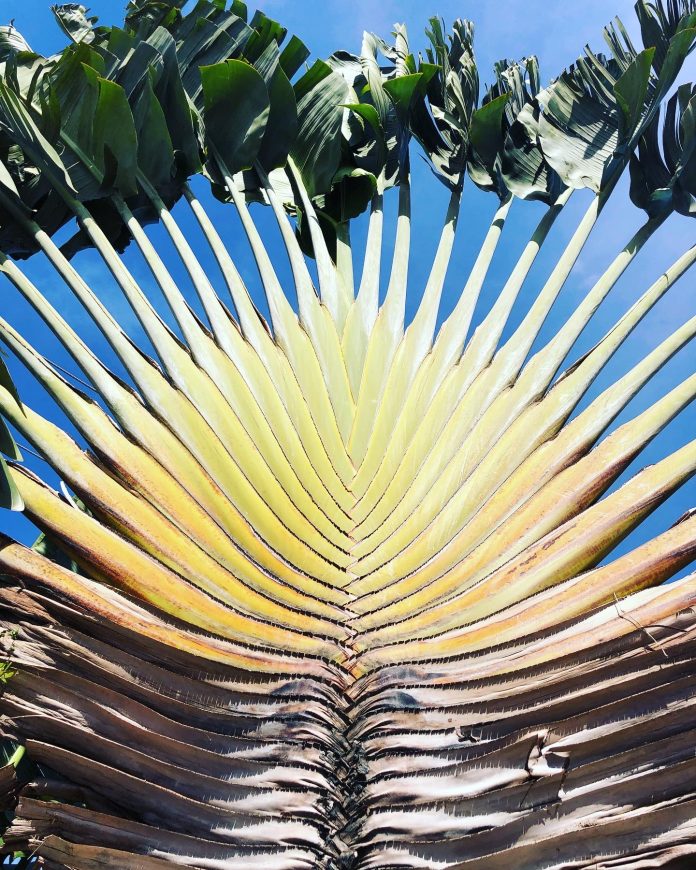Can the travellers palm (Ravenala madagascariensis) be grown in the united Kingdom?
With great difficulty. They will only tolerate temperatures down to freezing. This rules them out for being kept outside in the winter in the UK. Also they get really big – up to 30ft in height! The seeds are readily available in the UK but once they outgrow your conservatory they won’t survive outside.
The Traveller’s Palm: A Symbol of Tropical Splendor
The Traveller’s Palm (Ravenala madagascariensis) is a stunning and iconic plant that hails from the lush landscapes of Madagascar. Despite its name, the Traveller’s Palm isn’t a true palm but is more closely related to bananas (Musa spp.) and bird-of-paradise plants (Strelitzia spp.). Its unique structure, striking foliage, and practical history make it a captivating choice for gardens and landscapes worldwide.
Distinctive Features
The Traveller’s Palm gets its name from its fascinating adaptations. Its large, fan-shaped arrangement of leaves is not only visually striking but also practical—water collects in the leaf bases and stems, traditionally serving as a hydration source for weary travelers. The leaves grow in a flat, fan-like pattern, with each leaf aligned to maximize sunlight exposure. This symmetrical feature has made the plant a favorite among landscapers and tropical garden enthusiasts.
The plant produces beautiful, creamy-white flowers enclosed in boat-shaped bracts, although flowering is rare outside its native habitat. Over time, the plant can grow into a towering structure, reaching heights of up to 10 meters (33 feet) in ideal conditions. Its sturdy, cane-like stems add to its architectural appeal, making it a prominent feature in both indoor and outdoor settings.
Rich History and Cultural Significance
The Traveller’s Palm holds a significant place in the history and culture of Madagascar. Indigenous communities have long utilized various parts of the plant for practical purposes:
- Water Reservoirs: As mentioned, the leaf bases naturally collect rainwater, providing a vital source of hydration in the arid landscapes where water can be scarce.
- Shelter Construction: The large leaves are often used to thatch roofs or create shelters, offering protection from the elements.
- Traditional Medicine: Different parts of the plant are used in traditional remedies. The roots and bark are believed to have medicinal properties, employed in treatments for ailments ranging from fevers to digestive issues.
- Symbolism: In Malagasy culture, the Traveller’s Palm symbolizes resilience and adaptability, reflecting its ability to thrive in diverse and challenging environments.
The plant gained international attention during the era of colonial exploration when European botanists and travelers admired its unique form and practicality. Its exotic appearance made it a sought-after specimen in botanical gardens and private collections worldwide.
Botanical Facts
- Scientific Classification:
- Kingdom: Plantae
- Clade: Angiosperms
- Order: Zingiberales
- Family: Strelitziaceae
- Genus: Ravenala
- Species: Ravenala madagascariensis
- Growth Habit: Herbaceous perennial that can reach up to 10 meters in height with a spread of about 5 meters.
- Leaves: Long, strap-like leaves arranged in a fan pattern, typically 2 meters long and 40 centimeters wide. The leaves are evergreen, providing year-round foliage.
- Flowers: The inflorescence emerges from the center of the leaf fan and consists of multiple branches bearing flowers. While the plant is monocarpic (it flowers once before dying), flowering in cultivation is rare and often unpredictable.
- Fruit: Post-flowering, the plant can produce small, berry-like fruits that are consumed by birds and other wildlife in its native habitat.
Ecological Role
In Madagascar’s ecosystems, the Traveller’s Palm plays a crucial role:
- Habitat: Its large leaves provide shelter for various insects and small animals.
- Food Source: The fruits are a food source for birds and other wildlife, aiding in seed dispersal and maintaining ecological balance.
- Soil Stabilization: The extensive root system helps prevent soil erosion, particularly in coastal and hillside areas where the plant commonly grows.
Can the Traveller’s Palm Be Grown in the UK?
The Traveller’s Palm is not hardy enough to survive outdoors in the UK due to its sensitivity to cold temperatures. Frost and prolonged cold can severely damage or kill the plant. However, it is possible to grow the plant indoors or in a conservatory as a houseplant, provided its light and humidity requirements are met.
Growing Indoors:
- Location: Place it near a large, bright window to ensure it receives sufficient light. A south-facing window is ideal.
- Watering: Keep the soil consistently moist but not waterlogged. During the winter months, reduce watering slightly but never let the soil dry out completely. Misting the leaves regularly can help maintain humidity levels.
- Temperature: Ensure indoor temperatures remain above 15°C (59°F), even in winter. Avoid placing the plant near drafts or heating vents, which can cause temperature fluctuations.
- Soil and Potting: Use a rich, well-draining potting mix. Repot the plant every two to three years to accommodate its growth and refresh the soil nutrients.
Outdoor Cultivation During Warm Months:
- Shelter: If you have a conservatory or greenhouse, the Traveller’s Palm can thrive there during the warmer months. Alternatively, placing it in a sheltered patio or greenhouse can provide the necessary protection from sudden temperature drops.
- Acclimatization: Gradually acclimate the plant to outdoor conditions by introducing it to partial shade before exposing it to full sunlight.
- Bringing Indoors: As temperatures begin to fall, ensure the plant is brought back indoors to prevent frost damage.
Challenges and Care Tips
- Pests: Indoor plants can sometimes attract spider mites, mealybugs, or scale insects. Regularly inspect and clean the leaves with a damp cloth or use appropriate insecticidal treatments if necessary.
- Humidity: Traveller’s Palms thrive in high-humidity environments. In drier UK homes, especially during winter, consider using a humidifier or placing a water tray near the plant to increase ambient humidity.
- Lighting: Insufficient light can lead to leggy growth and reduced vigor. Ensure the plant receives ample indirect sunlight. Supplemental grow lights can be beneficial during the darker months.
- Propagation: While the Traveller’s Palm is generally propagated through seeds, which can be slow and challenging, some enthusiasts have had success with tissue culture methods.
- Pruning: Remove any dead or yellowing leaves to maintain the plant’s appearance and prevent potential pest infestations.
Conservation Status
The Traveller’s Palm is classified as “Least Concern” by the International Union for Conservation of Nature (IUCN). However, habitat destruction and deforestation in Madagascar pose threats to its natural populations. Sustainable cultivation practices and responsible sourcing from reputable nurseries can help mitigate these impacts.
Symbolism and Representation
Beyond its practical uses, the Traveller’s Palm holds symbolic meaning in various contexts:
- Resilience and Adaptability: Its ability to thrive in diverse conditions and regenerate after flowering underscores themes of resilience.
- Journey and Exploration: The name itself evokes images of travel and adventure, making it a popular motif in art and literature related to exploration.
- Exotic Elegance: Its striking appearance makes it a symbol of luxury and exoticism in interior design and landscape architecture.
Conclusion
While the Traveller’s Palm can’t survive the British climate outdoors, it can still bring a touch of the tropics to UK homes and conservatories with proper care. Its dramatic appearance, rich history, and fascinating biology make it a worthwhile addition for anyone passionate about exotic plants.
For UK gardeners dreaming of a tropical aesthetic, the Traveller’s Palm serves as a reminder of faraway lands, evoking the lush allure of Madagascar even in the heart of a cold winter. Its blend of beauty, functionality, and cultural significance ensures that it remains a cherished plant among horticulturists and plant enthusiasts alike.





